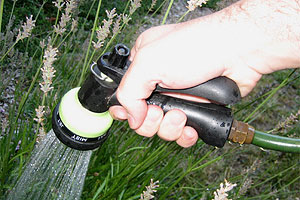Fix your fixtures
Replace old toilets and clothes washers-the biggest water users in your home-with new water efficient versions. Install low flow showerheads and aerators on faucets, and top your hose with an automatic shut-off nozzle. Check with your water district: They may offer rebates-or even free supplies-to help you make these changes.
Go native!
Replace conventional lawns and other thirsty plants with native species, which are more drought tolerant, resist pests, and provide great habitat. Use mulch to keep moisture in and weeds down. Water in the early morning or in the evening, when less is lost to evaporation, and avoid overwatering. If you use an automated irrigation system, install a rain shutoff device or soil moisture sensor.
Get creative
Rinse vegetables in a bowl of water rather than under a running tap, then reuse the rinse water for watering houseplants. Keep a pitcher in the refrigerator rather than waiting for tap water to get cold enough to drink. Hold a jug under the faucet while waiting for your shower to warm up, or even bring a bucket in the shower with you to capture some of the water for watering plants. And don't forget the easy and obvious: turn off the tap when brushing teeth, shaving, or washing dishes; run the dish- and clothes- washers only when full; trim a few minutes from your shower.
Speak up!
You don't need to write your legislator about urinals (though feel free), but do speak up in favor of conservation and environmental protection and restoration. Call or write your elected officials to let them know what's important to you, or pen a letter to the editor of the newspaper you read. When a water-saving couple in Sacramento was cited for letting their lawn die, there was a public outcry. In response, the city not only changed its mind about fining the couple, but also acknowledged city codes may need a drought-friendly update. You can also make your voice heard at the ballot box: Check out www.ecovote.org.
Befriend your watershed
Just as it can be hard to make the link between the neatly packaged food at the grocery and the farms it came from, we don't normally connect the dots between the water that magically comes out of our taps and the watersheds we live in. Millions of Bay Area residents rely on water not just from their local watersheds but also from the Delta and Sierra Nevada. Know where your water comes from and help protect those sources. And don't forget to get out and get to know the Bay and its tributaries: walking our river banks and shorelines, helping clean up your local creek, kayaking, rafting, sailing, birding, and swimming are just a few ways to interact with your watershed and can be great ways to teach kids the value of protecting our natural resources.
For more water saving ideas, visit www.watersavinghero.com, www.h2ouse.org, and www.bay.org/SimpleThingsYouCanDo.pdf -- or share your ideas below. Also don't miss my earlier post on what you can do to help the bay.
38.1048 -122.561
 I hadn't been working at The Bay Institute long when our then Executive Director dropped a packet of information on my desk and asked me to draft a letter. The topic? Urinals.
I hadn't been working at The Bay Institute long when our then Executive Director dropped a packet of information on my desk and asked me to draft a letter. The topic? Urinals.